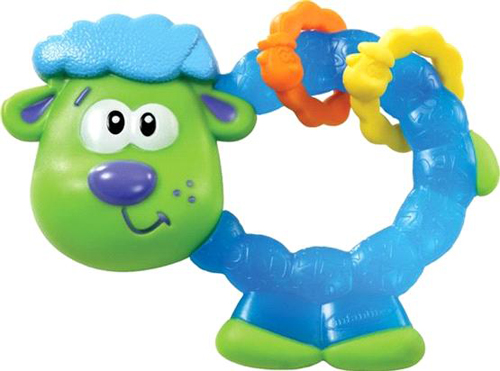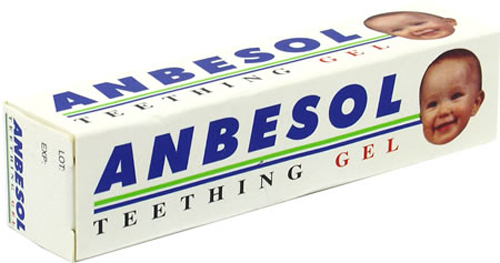When Baby begins teething, things are going to get much more difficult for Mommy and Daddy. Baby is going to be more irritable on top of all the other teething symptoms that are going to appear. So what can you look for to tell if you baby is teething and how can you make teething more comfortable for your little one? That’s what this article is all about. Let’s start with a little bit of information about teething.

What is Teething and Why is it so Painful?
Perhaps to make breastfeeding a whole lot less painful, babies are born without teeth. Pretty obvious. When a baby starts teething, their teeth are beginning to emerge through their gums. As the crown of Baby’s tooth is pushing through the gum, the root of that tooth is still developing below the gum line. This creates a sort of open wound in the baby’s gum and also causes a whole lot of pain. If you have had problems with your wisdom teeth, you may be able to understand the pain.
The thing about teething is that, in some ways at least, it is predictable. Teeth emerge in groups of four. Teething schedules will vary from baby to baby fairly dramatically. Some babies will start teething earlier than expected, others later and come right on time but all babies will have at least a few things in common. First, teeth emerge in groups of four. Teething generally begins around six months and ends around thirty months although, again, your baby may start and finish slightly off of those marks. In general, the following list should give you an idea of how your baby’s teeth will develop.
- Four lower incisors should begin emerging around six to eight months old.
- Four upper incisors should begin emerging around eight to ten months old.
- The first molars should begin emerging around twelve to fifteen months old.
- The upper and lower eye teeth should begin emerging around twenty to twenty-four months.
- The second molars should begin emerging around twenty to thirty months.
Some babies will develop teeth without obvious pain or discomfort but most babies will have quite a bit of trouble when their teeth are coming in. Your baby’s teeth began developing when it was still in your womb but they were developing under the gum and were far from fully formed teeth. The pain comes in when those teeth begin pushing through the gum.

Teething Symptoms
Teething symptoms can vary from baby to baby. Although most of the symptoms on the following list are common among all teething babies, your baby may not experience them all. The most common teething symptoms are as follows:
- Biting, sucking or rubbing gums
- Diarrhea
- Drooling (heavier than usual)
- High temperature
- Irritability
- Lack of sleep at night while still being wide awake during the day
- Problems when feeding (not feeding as much or as well)
- Redness in the cheeks
- Redness in the gums
- Restlessness
- Rubbing the ear (this should tell you which side of the mouth the tooth is emerging on)
Once you know what symptoms to look for, you can start figuring out what works for your baby to help soothe the pain.

How Can I Help Sooth Pain Caused by Teething?
Not to be repetitive, but all babies are different. Things that work to soothe teething symptoms for one baby may not work for another baby. Your best course of action is to let your baby tell you what helps them. Try out different methods and see which one your baby responds most positively to. Some excellent methods for soothing teething pain include:
- Offer Baby a teething ring. Try to avoid liquid based teething rings as you can’t sterilize them and the liquid has been known to leak in many of these types of rings. While the liquid is often safe, it can also be foul tasting which could cause Baby to turn away from them. Silicone based teething rings are a far better option. Many mothers put the rings in the fridge for a short period of time before offering it to their baby. The coolness of a ring from the freezer can really be soothing.
- Soothers can really help a teething baby. Although sucking makes the pain of teething worse (it gathers blood in the gums and makes swelling worse, hence many teething babies turning from the breast during feeding), most babies will chew on the nipple of their soothers, helping to sooth the pain. As with teething rings, you can pop these in the fridge for a few minutes before giving them to baby.
- Anything cold that baby can bite on will help. Try freezing a wet washcloth and giving that to baby to help sooth the pain. Unopened freezer pops can also be good as long as you keep an eye on your little one. You should also avoid Freezies with sharp plastic edges as they can cause sores or even cut Baby’s mouth or tongue. There are ‘edgeless’ freezer pops out there that can be a safer option. There are available at most supermarkets although you might have to do a little looking to find them. You want something that is wrapped in plastic (not paper) as well.
- Rubbing Baby’s gums can be a great help if Baby lets you put your fingers in its mouth. Not all babies are cool with this. You don’t want to make Baby any more unhappy than it already is!
- Babies older than six months who are teething might respond well to bagels, breadsticks, unbuttered toast or baby crackers but make sure you keep a close eye on them when they have anything they might be able to choke on. Fresh vegetables can also be a good option (carrots, celery, cucumbers etc) but the same deal applies. Watch them while they have anything they may be able to bite pieces off of. This is only a viable option for babies more than six months old.
- Once your baby starts on solid food, you can offer is fruit puree or plain yogurt.
- If nothing else is working, a good cuddle might just to the trick.
If your baby is more than three months old – which most babies will be when they start teething – you can offer infant acetaminophen to help with pain relief. You can also offer ibuprofen but only after baby is at least six months old and never in combination with acetaminophen. Many mothers avoid using acetaminophen and ibuprofen but as long as it’s used as directed and as long as you speak with your doctor first, it can really offer help many other options cannot.

Is Teething Gel a Good Option?
This one is kind of a complicated question. You really have to be careful where teething gels are concerned. Teething gels basically work using a local anesthetic that numbs the affected area and an anti-septic that helps ward off infection with the pain relief lasting roughly twenty minutes. Clearly those things are all positives. The problem lies in the fact that, inevitably, Baby is going to swallow at least a little bit of the gel. If they swallow enough, it could cause problems. If you’re going to use teething gel, follow these guidelines:
- Do not use teething gel on your baby more than six times a day.
- Use only a small amount of teething gel at a time.
- Only apply teething gel with a clean finger or with a clean cotton cloth.
I would recommend skipping teething gel is at all possible but honestly, some mothers feel its necessary, especially mothers whose babies are really suffering with teething symptoms. If your baby isn’t sleeping and is having a hard time eating, you need to do something to soothe the symptoms at least enough so it can do both of those things more easily. Remember though, you do not want to apply teething gel just before you breastfeed. It can numb Baby’s tongue and numb your nipple making the breastfeeding process harder for you and for Baby.











